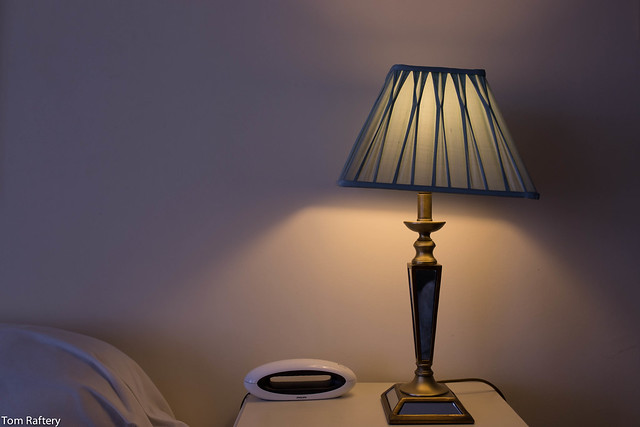Back in September 2012 I saw a Kickstarter campaign entitled LIFX: The Light Bulb Reinvented. The campaign promised to deliver
a WiFi enabled, multi-color, energy efficient LED light bulb that you control with your iPhone or Android
This sounded great. Energy efficient, LED bulbs which could change colour to match/create moods, and which you could control from your Smartphone? Where do I sign up? Well, I signed up on the Kickstarter page, obviously.
This morning, the Lifx bulbs I bought were delivered, so I decided to put them to the test.
The photo at the top of this post is of a lamp in my home powered by a 12W Philips CFL bulb. I swapped out the CFL for the Lifx LED bulb and I was immediately impressed with how quickly it lit up and how bright it is.
Here’s a comparison of the same lamp with first the CFL bulb, and then the Lifx LED bulb:
The photos were taken with identical camera settings* but look different due to the different brightness of the lights, and the different colour of their light. The lamp on the left is being lit by the Philips 12W CFL bulb, while the lamp on the right is being lit by the Lifx 17W LED wifi connected bulb.
A few comments in favour of the LED light –
- While it may look like the CFL bulb is brighter, in fact, that’s because most of its light is aimed downwards, while the LED bulb’s light is beamed upwards away from the table. In fact, the LED bulb is considerably brighter
- While not obvious from these photos, the LED bulb lights up instantaneously, whereas the CFL takes a good minute to come to full brightness
- The CFL is one colour, but the LED is whatever colour you set it to and
- The LED can be controlled from its Smartphone app over wifi
- The LED bulb is much bigger and heavier than the CFL bulb (this may, or may not be an issue for you)
- The LED bulb generates a LOT of heat
- The LED bulb, when turned off by the app, still consumes 2.7W of electricity (maintaining wifi so it can be turned on again presumably). To avoid this, it needs to be physically turned off at the switch.
- The LED bulb is expensive ($89 in the Lifx store) and
- Unfortunately the Lifx bulb is not remotely accessible – you need to be connected to wifi to turn it on or off, so if you’re out and realise you’ve forgotten to turn your lights off, there’s no way to turn them off from your smartphone (unless the very cool Revolv app starts to support Lifx bulbs).
- If you switch the Lifx bulb off at the wall, the bulb forgets its previous setting i.e. if you like a warm yellow light, and set it to that colour, as soon as you turn it off at the wall, it reverts to its default bright white on turning on again.
On the other hand –
And one more bonus thing you need to know (added after I was alerted to this by Andy Piper and I confirmed it as an issue with my Lifx bulbs)
Bottom line – the Lifx bulb is a nice little bulb and a great job by its developers for a v1.0 of their first product. Having said that, its main competitor seems to be the Philips Hue series of wifi connectable, colour variable, smartphone controllable bulbs, and they’re for sale on Amazon.com for $59.97 which is far cheaper than the Lifx at $89. Also, Revolv support the Hue series of bulbs, so it is likely they are remotely controllable. Given that, unless Lifx addresses particularly the cost issue, I’d have to advise anyone interested in Internet of Things connected lighting to look at the Philips solution instead. If I get my hands on the Philips bulbs, I’ll review them here subsequently.
One final note, the Philips CFL bulb rated at 12W was actually drawing 13.5W, while the Lifx bulb rated at 17W was drawing between 17W and 18W.
*Both photos were taken with the camera on full manual mode with shutter speed at 50, ISO at 200, aperture at 4.5, and white balance set for fluorescent light (4000k approx).




While cheaper , I believe the Hue requires a base station as well? I could be wrong.
After running my Lifx for a week, I’m impressed. Worth the money and I might get some more. Then again I’m a geek.
You can buy them now with free shipping using this link: http://mbsy.co/3WcMc